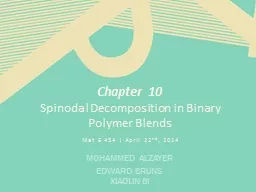PPT-Chapter 10
Author : sherrill-nordquist | Published Date : 2016-02-20
Spinodal Decomposition in Binary Polymer Blends Mat E 454 April 22 nd 2014 Mohammed Alzayer Edward Bruns XIAOLIN BI Outline Introduction Theory Ideal Solution
Presentation Embed Code
Download Presentation
Download Presentation The PPT/PDF document "Chapter 10" is the property of its rightful owner. Permission is granted to download and print the materials on this website for personal, non-commercial use only, and to display it on your personal computer provided you do not modify the materials and that you retain all copyright notices contained in the materials. By downloading content from our website, you accept the terms of this agreement.
Chapter 10: Transcript
Download Rules Of Document
"Chapter 10"The content belongs to its owner. You may download and print it for personal use, without modification, and keep all copyright notices. By downloading, you agree to these terms.
Related Documents














